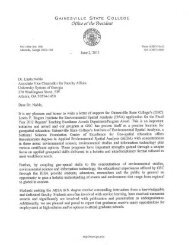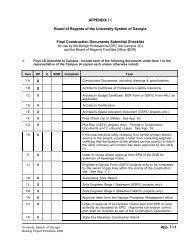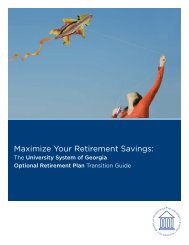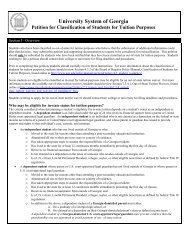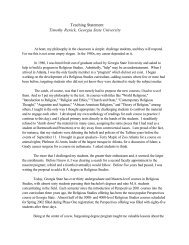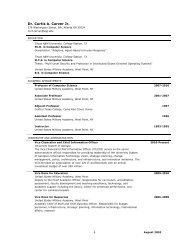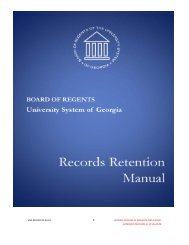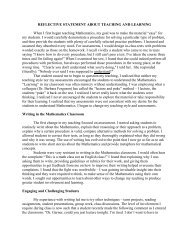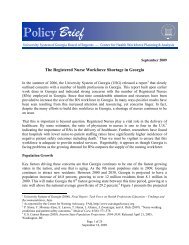66848 Federal Register / Vol. 75, No. 209 / Friday, October 29, 2010 / Rules and RegulationsWReier-Aviles on DSKGBLS3C1PROD with RULES2institution. In cases where the amount<strong>of</strong> credit hours assigned to a program issignificantly overstated, the Secretarymay fine the institution or limit,suspend, or terminate its participationin Federal programs.Changes: None.Comment: Some commenters believedthat the proposed credit-hour definitionwould alter institutions’ current creditassignments and courses. A few <strong>of</strong> thesecommenters believed that a Federaldefinition <strong>of</strong> a credit hour sets anexpectation that institutions shouldassign additional credit to courses if thework exceeds the amount defined in theproposed definition. One commenterbelieved that the proposed definitionwould increase the amount <strong>of</strong> class timethat students are required to complete inorder to earn credit. Another commenterbelieved that the proposed definitioncould cause institutions to increasecourses’ lecture or theory content anddecrease hands-on training.One commenter believed that theproposed credit-hour definition wouldforce accrediting agencies to imposehomework requirements on vocationalinstitutions.Discussion: The credit-hour definitiondoes not require institutions to altertheir assignment <strong>of</strong> credit to courses foracademic purposes; however,institutions have the responsibility todemonstrate that credit hours assignedto courses for Federal program purposesadhere to the minimum standards <strong>of</strong> thecredit-hour definition in § 600.2. If aninstitution determines that its currentassignment <strong>of</strong> credits to its programs forFederal program purposes does notsatisfy the minimum standards in theregulation, the institution will eitherhave to reduce the credits associatedwith the program, increase the workrequired for the program, or both.There is no requirement forinstitutions to assign additional credit tocourses if the amount <strong>of</strong> work exceedsthe amount described in paragraph (1)<strong>of</strong> the credit-hour definition. We haverevised the credit-hour definition in§ 600.2 to clarify that the amount <strong>of</strong>work described in paragraph (1)represents a minimum acceptable level<strong>of</strong> academic activity for which creditcan be awarded to constitute a credithour for Federal purposes. Institutionsmay use their discretion to assignadditional credit if the amount <strong>of</strong> workfor a course justifies such an assignment<strong>of</strong> credit in accordance with § 600.2.There is no requirement under thecredit-hour definition that would forceaccrediting agencies to imposehomework requirements on vocationalinstitutions. In general, institutions willbe assessed to determine if they haveestablished credit hours for title IV,HEA program purposes that meet atleast the minimum standards in theregulation. Unless the program issubject to the credit-to-clock-hourconversion requirements in § 668.8(l)and (k), an institution would berequired to determine the appropriatecredit hours in accordance withparagraphs (1) and (2) <strong>of</strong> the credit-hourdefinition in § 600.2 <strong>of</strong> these finalregulations for a program or courseworkin a program that has no student workoutside the classroom.Changes: We have revised the credithourdefinition in § 600.2 to clarify thatthe amount <strong>of</strong> work specified inparagraph (1) is a minimum standardand that there is no requirement for thestandard to be exceeded.Comment: One commenter believedthat the proposed provisions in § 600.2did not appropriately address facultyworkloads or faculty time in class.Discussion: We do not believe that§ 600.2 should address facultyworkloads or faculty time in class asthese issues are institutionaladministrative considerations outsidethe scope <strong>of</strong> these final regulationswhich set minimum standards for themeasurement <strong>of</strong> credit hours.Changes: None.Comment: One commenter questionedwhy the proposed credit-hourregulations did not address § 668.9which provides in paragraph (b) that apublic or private nonpr<strong>of</strong>it hospitalbasedschool <strong>of</strong> nursing that awards adiploma at the completion <strong>of</strong> theschool’s program <strong>of</strong> education is notrequired to apply the formula containedin § 668.8(l) to determine the number <strong>of</strong>semester, trimester, or quarter hours inthat program for purposes <strong>of</strong> calculatingTitle IV, HEA program funds. Thiscommenter questioned whether forpr<strong>of</strong>ithospital-based nursing programswould be subject to the proposedprovisions in § 668.8(k) and (l).Discussion: Section 481A <strong>of</strong> the HEAand § 668.9(b) specify that anyregulations promulgated by theSecretary concerning the relationshipbetween clock hours and semester,trimester, or quarter hours in calculatingstudent grant, loan, or work assistanceunder the title IV, HEA programs do notapply to a public or private nonpr<strong>of</strong>ithospital-based school <strong>of</strong> nursing thatawards a diploma at the completion <strong>of</strong>the school’s program <strong>of</strong> education.Changes: None.Comment: One commenter believedthat institutions would need anaccrediting or State agency’s review <strong>of</strong>their programs’ compliance with theproposed credit-hour definition in§ 600.2. The commenter believed thatVerDate Mar2010 14:10 Oct 28, 2010 Jkt 223001 PO 00000 Frm 00018 Fmt 4701 Sfmt 4700 E:\FR\FM\29OCR2.SGM 29OCR2the regulations are unclear on howprograms should operate in the interim.One commenter expressed concernthat waiting for accrediting agencies torevise their standards after the proposedregulations are finalized would bedetrimental to institutions <strong>of</strong>feringprograms in alternative formats.One commenter believed thatinstitutions will be developing newcredit policies and should be affordedan adjustment period to receive andreact to guidance from State agencies ontheir credit assignment policies.Discussion: The provisions in§§ 602.24 and 603.24 provide that aninstitution must have a process forassigning credit that meets itsaccrediting agency’s or State agency’sstandards, as well as, the credit-hourdefinition in § 600.2. An institution’scredit assignment process is subject toreview by its accrediting agency or, insome cases, a State agency recognizedunder 34 CFR part 603. We believe thatinstitutions already have processes forassigning credit and, to the extent thatthese existing processes do not complywith these final regulations, institutionswill need to revise their creditassignments to comply with the credithourdefinition in these final regulationsfor Federal program purposes. Duringthe interim period between the effectivedate <strong>of</strong> these regulations and anaccrediting agency’s or State agency’sreview <strong>of</strong> institutions’ compliance withthe credit-hour definition in § 600.2, aninstitution is responsible andaccountable for ensuring that its credithourassignments conform to theprovisions <strong>of</strong> the credit-hour definitionin § 600.2 <strong>of</strong> these final regulations andthat its processes are in accord with itsdesignated accrediting agency’s orrecognized State agency’s requirements.Changes: None.Out-<strong>of</strong>-Class Student WorkComment: Several commenters didnot agree with the component <strong>of</strong>proposed paragraph (1) <strong>of</strong> the credithourdefinition related to student workoutside <strong>of</strong> class. A few commentersbelieved that an institution cannotdetermine how much time studentsspend on work outside <strong>of</strong> class and thatquantifying work outside <strong>of</strong> the classdoes not account for variations instudents’ learning abilities and styles.One commenter believed that theSecretary’s proposed credit-hourdefinition did not take into account thenature <strong>of</strong> different courses. Thiscommenter believed that certain coursesrequire more direct faculty instructionand supervision while other coursesmay require more study outside <strong>of</strong> theclassroom.
Federal Register / Vol. 75, No. 209 / Friday, October 29, 2010 / Rules and Regulations66849WReier-Aviles on DSKGBLS3C1PROD with RULES2Two commenters did not agree withthe Secretary’s proposed credit-hourdefinition with regard to the ratio <strong>of</strong>classroom time to time outside <strong>of</strong> classand suggested revising the proposeddefinition to allow for more directclassroom instruction. Thesecommenters recommended revisingproposed paragraph (1) to define acredit hour as one hour <strong>of</strong> classroom ordirect faculty instruction and aminimum <strong>of</strong> two hours <strong>of</strong> student workin or out <strong>of</strong> the classroom.One commenter recommended thatthe <strong>Department</strong> distinguish class timefrom time outside <strong>of</strong> class by makingexplicit in the proposed definition thatclass time refers to instruction.One commenter asked for clarification<strong>of</strong> proposed paragraph (2) regardingwhether a credit hour awarded forlaboratory work must consist <strong>of</strong> onehourwork in the laboratory and twohours outside the laboratory performingeither preparation or follow upactivities.Discussion: Institutions mustdemonstrate that the credit hoursawarded for the amount <strong>of</strong> academicwork necessary for Federal programpurposes approximates the amount <strong>of</strong>work defined in paragraph (1) <strong>of</strong> thedefinition <strong>of</strong> credit hour in § 600.2. Thecredit-hour definition in § 600.2 sets aminimum standard and institutions may<strong>of</strong>fer additional hours <strong>of</strong> instructionaltime to courses or provide for additionalstudent work outside <strong>of</strong> class beyondwhat is specified in paragraph (1) <strong>of</strong> thedefinition at their discretion. We do notbelieve it is necessary to decrease theamount <strong>of</strong> out-<strong>of</strong>-class time specified inparagraph (1) <strong>of</strong> the definition.We do not want to limit theinterpretation <strong>of</strong> class time only todirect instruction in order to take intoconsideration other in-class activitiessuch as examinations. Similarly, theprovisions related to laboratory work inparagraph (2) <strong>of</strong> the definition do notrequire one hour <strong>of</strong> work in thelaboratory and two hours <strong>of</strong> out-<strong>of</strong>-classwork related to the laboratory.Paragraph (2) <strong>of</strong> the credit-hourdefinition allows institutions to usetheir discretion to determine the in-classand out-<strong>of</strong>-class components forlaboratory work to the extent the creditawarded reasonably approximates therequirements <strong>of</strong> paragraph (1) <strong>of</strong> thecredit-hour definition in § 600.2. Aninstitution’s basis for making thisdetermination would be subject toreview by its accrediting agency, theState agency recognized under 34 part603, and the <strong>Department</strong> in order todemonstrate that it was reasonable.Changes: None.Authority and Need To RegulateComment: Several commentersbelieved that the Secretary does nothave the legal authority to promulgatethe proposed regulations in §§ 600.2,602.24, 603.24, and 668.8. Thesecommenters believed the credit-hourdefinition in proposed § 600.2represented a Federal intrusion intoacademic matters. A few commentersbelieved that the General <strong>Education</strong>Provisions Act (20 U.S.C. 1232a) and the<strong>Department</strong> <strong>of</strong> <strong>Education</strong> OrganizationAct (20 U.S.C. 3403) prohibit theSecretary from exercising undue control<strong>of</strong> curricula, programs, administration,and personnel <strong>of</strong> educationalinstitutions. These commenters believedthat the Secretary needs explicitCongressional authorization topromulgate regulations that intrude inthe academic decision-making processat institutions. Two commentersrecommended including language in thefinal regulations reaffirming that it isappropriate for institutions andaccrediting agencies to address studentachievement, but that it is not withinthe Secretary’s authority.Many commenters believed that aFederal definition <strong>of</strong> a credit hourrepresents a Federal intrusion into acore academic issue and the academicdecision-making process. A few <strong>of</strong> thesecommenters expressed concern that aFederal definition <strong>of</strong> a credit hourwould set a precedent for Federalinterference in other academic matters.One commenter representinginstitutional registrars and admissions<strong>of</strong>ficers believed the proposed definition<strong>of</strong> a credit hour should be revised torequire an institution to make areasonable determination <strong>of</strong> whether theinstitution’s assignment <strong>of</strong> credit hoursconforms to commonly acceptedpractice in higher education asdemonstrated in the portability <strong>of</strong> suchcredits to other institutions <strong>of</strong> highereducation <strong>of</strong>fering similar programs.One commenter believed that theSecretary is not authorized to makeacademic decisions and did not wantinstitutions to be subject to any adverseadministrative action by the <strong>Department</strong>if the <strong>Department</strong> did not concur withan institution’s or accrediting agency’sdetermination <strong>of</strong> appropriate credit.This commenter suggested that the finalregulations specify that the credit hoursawarded for a program shall be deemedin compliance with the definition <strong>of</strong> acredit hour as defined in § 600.2, wherethe credit hours awarded have beenapproved by the institution’s accreditingagency based upon a review performedin accordance with § 602.24(f).VerDate Mar2010 14:10 Oct 28, 2010 Jkt 223001 PO 00000 Frm 00019 Fmt 4701 Sfmt 4700 E:\FR\FM\29OCR2.SGM 29OCR2Several commenters believed that theSecretary’s proposed credit-hourdefinition was incongruent withexisting Federal laws, State regulations,or accrediting agency policies.One commenter believed that theproposed credit-hour definition in§ 600.2 could conflict with theAmericans with Disabilities Act <strong>of</strong> 1990,as amended, which requires entitiessuch as institutions <strong>of</strong> higher educationto make reasonable accommodations forstudents with disabilities.Several commenters believed that theproposed credit-hour definition wouldforce some institutions that use credithours to use clock hours. Thesecommenters believed that this changewould conflict with some Stateregulations and is not required by anyother Federal agency.A few commenters believed that theproposed credit-hour regulations wereharmful to institutions that had beenrequired to convert from clock hours tocredit hours by State mandates. Thesecommenters believed that theseinstitutions would be at a disadvantagecompared to institutions that werepreviously using credit hours. Onecommenter recommended that the<strong>Department</strong> allow institutions that haveconverted to credit hours based on Statemandates to use State-mandated clockto-credit-hourconversion rates todetermine Federal program eligibility.Several commenters believed that theproposed credit-hour definition maydirectly violate some State regulationsbecause it inherently requires thatinstitutions take attendance.Discussion: The Secretary isauthorized under 20 U.S.C. 1221e–3, tomake, promulgate, issue, rescind, andamend rules and regulations governingthe manner <strong>of</strong> operation <strong>of</strong>, andgoverning the applicable programsadministered by, the <strong>Department</strong>. Theintent <strong>of</strong> the regulations in §§ 600.2,602.24, 603.24, and 668.8 is not tointerfere with the academic decisionmakingprocesses at institutions,accrediting agencies, and recognizedState agencies, but to rely on theseprocesses to ensure the integrity <strong>of</strong> theFederal programs, including the title IV,HEA programs. Fundamental to thesedecision-making processes is themeasurement <strong>of</strong> the credit used todetermine the amounts <strong>of</strong> title IV, HEAprogram funds provided to eligiblestudents who are enrolled in eligibleprograms. Since the regulationsestablish a minimum standard, andinstitutions may choose to include morework for their credit hours than theminimum amount, credit hours at oneinstitution will not necessarily equate tocredit hours at another institution for a
- Page 1 and 2: Friday,October 29, 2010Part IIDepar
- Page 3 and 4: Federal Register / Vol. 75, No. 209
- Page 6 and 7: 66836 Federal Register / Vol. 75, N
- Page 8 and 9: 66838 Federal Register / Vol. 75, N
- Page 10 and 11: WReier-Aviles on DSKGBLS3C1PROD wit
- Page 12 and 13: 66842 Federal Register / Vol. 75, N
- Page 14 and 15: 66844 Federal Register / Vol. 75, N
- Page 16 and 17: WReier-Aviles on DSKGBLS3C1PROD wit
- Page 20 and 21: 66850 Federal Register / Vol. 75, N
- Page 22 and 23: WReier-Aviles on DSKGBLS3C1PROD wit
- Page 24 and 25: 66854 Federal Register / Vol. 75, N
- Page 26 and 27: WReier-Aviles on DSKGBLS3C1PROD wit
- Page 28 and 29: 66858 Federal Register / Vol. 75, N
- Page 30 and 31: 66860 Federal Register / Vol. 75, N
- Page 32 and 33: 66862 Federal Register / Vol. 75, N
- Page 34 and 35: 66864 Federal Register / Vol. 75, N
- Page 36 and 37: 66866 Federal Register / Vol. 75, N
- Page 38 and 39: WReier-Aviles on DSKGBLS3C1PROD wit
- Page 40 and 41: WReier-Aviles on DSKGBLS3C1PROD wit
- Page 42 and 43: 66872 Federal Register / Vol. 75, N
- Page 44 and 45: WReier-Aviles on DSKGBLS3C1PROD wit
- Page 46 and 47: WReier-Aviles on DSKGBLS3C1PROD wit
- Page 48 and 49: WReier-Aviles on DSKGBLS3C1PROD wit
- Page 50 and 51: 66880 Federal Register / Vol. 75, N
- Page 52 and 53: WReier-Aviles on DSKGBLS3C1PROD wit
- Page 54 and 55: 66884 Federal Register / Vol. 75, N
- Page 56 and 57: 66886 Federal Register / Vol. 75, N
- Page 58 and 59: WReier-Aviles on DSKGBLS3C1PROD wit
- Page 60 and 61: WReier-Aviles on DSKGBLS3C1PROD wit
- Page 62 and 63: WReier-Aviles on DSKGBLS3C1PROD wit
- Page 64 and 65: WReier-Aviles on DSKGBLS3C1PROD wit
- Page 66 and 67: WReier-Aviles on DSKGBLS3C1PROD wit
- Page 68 and 69:
WReier-Aviles on DSKGBLS3C1PROD wit
- Page 70 and 71:
WReier-Aviles on DSKGBLS3C1PROD wit
- Page 72 and 73:
66902 Federal Register / Vol. 75, N
- Page 74 and 75:
WReier-Aviles on DSKGBLS3C1PROD wit
- Page 76 and 77:
WReier-Aviles on DSKGBLS3C1PROD wit
- Page 78 and 79:
66908 Federal Register / Vol. 75, N
- Page 80 and 81:
WReier-Aviles on DSKGBLS3C1PROD wit
- Page 82 and 83:
66912 Federal Register / Vol. 75, N
- Page 84 and 85:
WReier-Aviles on DSKGBLS3C1PROD wit
- Page 86 and 87:
66916 Federal Register / Vol. 75, N
- Page 88 and 89:
WReier-Aviles on DSKGBLS3C1PROD wit
- Page 90 and 91:
WReier-Aviles on DSKGBLS3C1PROD wit
- Page 92 and 93:
WReier-Aviles on DSKGBLS3C1PROD wit
- Page 94 and 95:
66924 Federal Register / Vol. 75, N
- Page 96 and 97:
WReier-Aviles on DSKGBLS3C1PROD wit
- Page 98 and 99:
66928 Federal Register / Vol. 75, N
- Page 100 and 101:
WReier-Aviles on DSKGBLS3C1PROD wit
- Page 102 and 103:
66932 Federal Register / Vol. 75, N
- Page 104 and 105:
WReier-Aviles on DSKGBLS3C1PROD wit
- Page 106 and 107:
66936 Federal Register / Vol. 75, N
- Page 108 and 109:
66938 Federal Register / Vol. 75, N
- Page 110 and 111:
66940 Federal Register / Vol. 75, N
- Page 112 and 113:
66942 Federal Register / Vol. 75, N
- Page 114 and 115:
66944 Federal Register / Vol. 75, N
- Page 116 and 117:
66946 Federal Register / Vol. 75, N
- Page 118 and 119:
WReier-Aviles on DSKGBLS3C1PROD wit
- Page 120 and 121:
WReier-Aviles on DSKGBLS3C1PROD wit
- Page 122 and 123:
WReier-Aviles on DSKGBLS3C1PROD wit
- Page 124 and 125:
66954 Federal Register / Vol. 75, N
- Page 126 and 127:
WReier-Aviles on DSKGBLS3C1PROD wit
- Page 128 and 129:
66958 Federal Register / Vol. 75, N
- Page 130 and 131:
66960 Federal Register / Vol. 75, N
- Page 132 and 133:
WReier-Aviles on DSKGBLS3C1PROD wit
- Page 134 and 135:
WReier-Aviles on DSKGBLS3C1PROD wit
- Page 136 and 137:
WReier-Aviles on DSKGBLS3C1PROD wit
- Page 138 and 139:
66968 Federal Register / Vol. 75, N
- Page 140 and 141:
66970 Federal Register / Vol. 75, N
- Page 142 and 143:
66972 Federal Register / Vol. 75, N
- Page 144 and 145:
66974 Federal Register / Vol. 75, N



